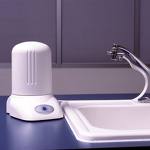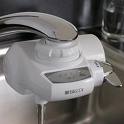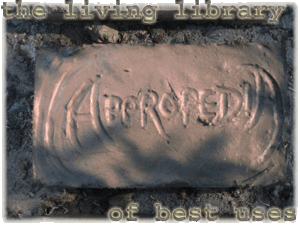

Abstract
Background
For our class project, we chose to compare home water filtration devices. We decided upon Brita's Aquaview model and Multi-Pure's MPAD Aqua Dome model. We wanted to see which filter was best for the environment, your health, and your money. As you will see, one system costs much more than the other, one system filters much more than the other, and one leaves a gigantic carbon footprint. This Comparison/Analysis was conducted for Engineering 308 - Technology and the Environment, at Humboldt State University by: Bryan Thompson, Dana Martin, Kristi Morton and Kristy Method.
Brita has been mass producing water filtration systems for the average consumer since 1966 based on creating the best tasting, healthy water with the simplest filtering system. In recent years, the company has moved its production off United States soil and onto China and Malaysia ground. Brita has recently announced that they are starting a recycling program for all of their replaceable filters, which is based in Massachusetts.
Multi-Pure is a water filtration company based out of Las Vegas that has been producing custom, advanced water filtration systems on a customer-by-customer basis since 1970. There is a single independent business owner that supplies Multi-Pure water filtration systems to the greater part of Humboldt County and probably one in most cities too. This company produces all of its water filtration systems in Las Vegas and ships these systems via UPS Ground or UPS Air depending on how far the customer is from Las Vegas.
Problem statement
Which system is the best for Arcata residents who want to make the least impact on their wallet and the environment while receiving the healthiest water that they can?
Our project compares water filtration systems by Multi-Pure and Brita. We are comparing the two types of water filtration systems on financial cost, CO2 released in transport and contaminants released into a person, in order to discover which is most appropriate for people living in Arcata, California. Brita and Multi-Pure filtering systems both offer similar technology to filter the water, but what does it take for those filters to make it to a consumer's home?
We are assuming that a household will have four people in it, that the flow of water will stay constant and no additional contaminants will be introduced into the system other than what our data supplied by Humboldt Municipal Water District provided. Brita provide basic information, through a phone interview, on where and how their filtering system is produced and shipped. We will also consider, if assembled in another country, any information on what the filter is made of; how many gallons does it filter before replacement is recommended; and any other relevant information that we request. It is assumed that this company will not give us all the information in detail that we want. Multi-Pure is expected to give similar data and information about its product as Brita and offer any some additional insight that Brita won't comment on.
Instructions

Here is some help uploading files.
To find out your carbon footprint associated with each type of water filtration system click the following link. *this only considers transportation and disposal.Media:Totals.xls
- Answer the first question at the top of the page in orange, enter your answer in the green boxes located to the right of the question for each system as to what percentage of the time you plan on recycling each filter (as of 12/12/08, Multi-Pure has no recycling program instituted).
- Answer the second question as to how far away you live from each location for recycling of each systems filter. Brita's recycling plant is currently located in Massachusetts and as of 12/12/08, Multi-Pure has no recycling program instituted.
- For the third question, you must find out how far away you live from the landfill used for your county or city. Once this information is obtained, enter the mileage in each box to the right of the question. This should be the same for both filters.
- For the fourth question, enter what your is distance from Las Vegas, Nevada, which is where Multi-Pure is produced. Next enter how far away you are from Oakland, California. Brita is not actually manufactured here, but all of the systems shipped to the U.S. come here from China on a boat. The boat transport is automatically factored in for the amount of CO2 produced during transportation.
- Once all of this data has been entered, look to the graph toward the bottom right of this sheet to see how much CO2 is being emitted with each type of filter.
Justifications
- The materials list is included for your information, we did not incorporate it into our analysis.
- We assumed a household of 4 people, and filter to be changed (at 750 gallons for Multi-pure & 300 gallons for Brita) per manufacture recommendations, based on filter life/time (gallons/year)
- Assume average of 15 mpg from big rig and the rugged terrain from SF Bay to Arcata, CA
- Assume reserve tanks not used and airplane 3/4 filled with packages. (Packages weigh less then passengers) Information from Boeing website.
- Assume 53 ft. container comparison and calculation discovered @ http://many-ideas.blogspot.com/2007/04/local-produce-vs-international-peace.html
- Assume we are considering plastic, metal, paper, glass. I added these together to get the amount that Arcata recycles. In the article it stated that all of these combined added up to 80% http://gohumboldthomes.wordpress.com/2008/10/25/where-does-your-recycling-end-up-tour-of-arcata-and-eureka-ca-recycling-facility/
- Brita recycled in Waltham, MA
- Assuming both disposal vehicles are using C12H26 Diesel
- Combustion for diesel: C12H26 + 18.5 O2 + 69.6 N2 --> 12CO2 + 13 H2O *69.6N2 C12H26 = 170 g (diesel) & 528 g (CO2)
- Combustion for jet fuel: C12H23 + 17.8 O2 + 66.8 N2 --> 12 CO2 + 11.5 H2O + 66.8 N2 C12H26 = 167 g (jet) & 528 g (CO2)
- Combustion for fuel oil: C20H42 + 30.5 O2 + 114.7 N2 --> 20 CO2 + 21 H2O + 114.7 N2 C20H42 = 282 g (oil) & 880 g (CO2)
- Density of diesel: .85 Kg/L = 850 Kg/m^3 Wikipedia
- Density of jet fuel: 6.76 lb/gal = 811Kg/m^3 www.aviationweek.com/aw/generic/story_generic.jsp?channel=bca&id=news/fuel0606.xml
- Density of fuel oil: .784 g/cm^3 = 784 Kg/m^3 www.chemspider.com/Chemical-structure.393886.html
- For Multipure, we are assuming that each system gets shipped when it is ordered. For Brita this calculation is the whole shipment of Brita filters (they don't send one at a time)
- We assumed one filter is being shipped at a time for brita. This is definitely skewed since more than one are going to be shipped from China at once. For the person to get there one filter it is still going to emit the same amount of CO2 to get the filter they purchase.
Results
Enter your own data to see your carbon footprint with regards to getting the filter to you and disposal of product based on where you live.
Media:Totals.xls
Conclusions
Discussion and next steps
One section of this analysis that was not explored, was in regard to the materials used to produce the water filtration systems. We were able to get some information about what each filtration system was made of, but were unable to explore how those materials were manufactured, what goes into them, can they be recycled, what their impact to the environment is during disposal, and, if they are placed in a landfill, what is their rate of deterioration?
References
See Help:Footnotes for more.
http://www.purestdrinkingwater.com/mpad.jpg (aquadome photo) http://static.howstuffworks.com/gif/productImages/2/8/00000102928-BritaAquaViewOnTapFaucetFilter-large.jpeg (aquaview photo)
<layout name="Spreadsheet analysis" />